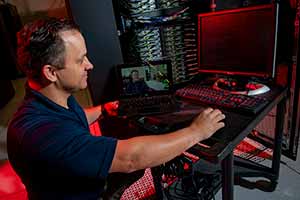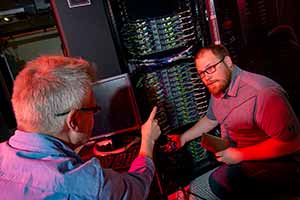
Contact Us
Institutional Communications
Bureau of Mines Building, Room 137
Laramie, WY 82071
Phone: (307) 766-2929
Email: cbaldwin@uwyo.edu
UWs ARCC Provides High
Published November 04, 2020

Michael Killean (seated), interim director of ARCC, communicates with Jeff R. Lang,
project manager of Information Technology, via Zoom. ARCC’s primary mission is to
enable and facilitate research on campus through high-performance computing. (UW Photo)
One of Lars Kotthoff’s computer science students uses the University of Wyoming’s Advanced Research Computing Center (ARCC) to analyze artificial intelligence algorithms. Meanwhile, the Wyoming Geographic Information Science Center (WyGISC) has moved much of the base spatial data that drives its web-mapping applications to the petaLibrary over the last four years, according to Shannon Albeke.
No matter the use, UW faculty and staff using Teton, a high-performance computing cluster, the petaLibrary, a digital storage system, or any other service managed by ARCC are grateful to have the convenience of a high-performance computing facility on campus that can run computations quickly and provide high storage capacity.
“Generally, my research is about analyzing the behavior of algorithms to be able to reason about their behavior in different contexts,” says Kotthoff, a UW assistant professor of computer science. “The field is called meta-algorithmics. We're not developing new algorithms but, rather, using existing ones more efficiently and effectively. This could be in terms of the quality of the achieved solution or the resources required to solve a problem.”
Kotthoff says the work requires running large-scale computational experiments to gather the empirical data they use to train machine-learning models. This allows his research group to predict how an algorithm will behave in a new context. Since Jan. 1, Kotthoff’s group has used about 800 CPU years on Teton. A CPU year is equal to roughly 8,760 hours.
WyGISC has several new applications under development that will depend almost entirely upon ARCC cyberinfrastructure, says Albeke, a senior research scientist with WyGISC.
“We are developing an application based entirely on R Shiny to allow users to upload ungulate migration data from across the globe,” he says. “Similarly, in conjunction with the Wyoming Migration Initiative, we are developing an integrative web-mapping application, DEVISE.”
DEVISE (Derived Environmental Variability Indices Spatial Extractor) is aimed at providing a user-friendly system to calculate derived metrics of environmental variability from federated data products (MODIS satellite imagery) and algorithms, and use those products to develop an empirical understanding of how environmental predictability underlies the movement strategies of animals in the Rocky Mountain region, Albeke says.
ARCC: UW Resource for a Decade
Founded in 2010 under the guidance of initial director Tim Kuhfuss as a unified research support group for UW students, staff and faculty, ARCC is a team of highly trained professionals with backgrounds in research, computing systems and information technology (IT) support.
“The ARCC’s primary mission is to enable and facilitate research on campus,” says Michael Killean, ARCC’s interim director. “We are a support unit that provides IT-like systems, services and consultation to campus researchers at little to no cost. We provide a flexible workflow and are always oriented to ensuring research is supported adequately.”
ARCC’s primary service, which provides the most impact to UW, is the Teton High Performance Compute cluster. Teton was originally installed in 2010 under the moniker of Mount Moran by Kuhfuss with system design created by Jeff R. Lang, project manager of Information Technology.
“Rebranded as Teton, it is 530 computational servers and growing,” Killean says. “Jeff has been a core part of ARCC from day one and is indispensable.”
ARCC provides more equipment and services than peer institutions that typically have more staff, Killean adds. ARCC currently has four full-time staff, and has plans to hire a new director and additional support personnel in the near future. It also employs student workers, when applicable. Simon Alexander is ARCC’s software manager.

Simon Alexander (left), ARCC’s software manager, and Dylan Perkins, ARCC’s end user
support manager, observe a computer rack that is part of the Teton High Performance
Compute cluster. (UW Photo)
“He’s our most recent hire and has put in a tremendous amount of work helping our end users not only make their code functional, but to optimize usage across the cluster,” Killean says. “This has a drastic effect on the amount of research that can be performed on all of ARCC’s services.”
“Many of us regard their efforts in research support to be heroic, especially given the skeleton crew they have,” says Ed Synakowski, vice president for the Office of Research and Economic Development. “To be sure, I’ve known this for some time, and the opportunity exists, as does the mandate, to grow this and make ARCC something even much more impactful. This is all due to President Ed Seidel’s vision.”
In 2018, ARCC was moved out of Information Technology and placed under the auspices of the Office of Research and Economic Development. ARCC is currently housed in the IT building.
In 2019, ARCC was reorganized to better serve the campus research community as a whole. ARCC was split into areas of focus to enable its staff members to best utilize their skills, Killean says.
“We have moved from an ‘everyone does everything’ approach to a more focused and prioritized
organization,” Killean explains. “While we still work extremely closely with each
other, we have prioritized into teams: technical systems, software consultation, and
end user support and training.”
Technical systems is responsible for systems administration, architecture/design and
general operations of ARCC’s services. Software consultation focuses on installation
and providing assistance with scientific computational software, in addition to managing
the software on the high-performance computing clusters. End user support is responsible
for supporting users’ use of ARCC’s services, including Linux desktop support.
“That has been a major focus for our group as a whole, but the team specifically has focused on revamping our documentation and training services,” Killean says. “Specifically, Dylan Perkins, our end user support manager, has made a substantial push to generate online courses to help researchers utilize our services.”
Overhaul Planned for petaLibrary
The petaLibrary, a digital storage system that enhances UW and other researchers’ ability to store and share data with collaborators and students around the world, launched Nov. 1, 2016. The petaLibrary is a storage service for UW researchers who need to reliably store and exchange data with students and collaborators anywhere in the world. It also is a place for UW researchers to store data linked to publications; store data sets as publications themselves; and be in compliance with funder requirements.
Killean says the petaLibrary was purchased with a key piece of software that would
migrate data -- that was not accessed often -- to slower, but more reliable storage.
Unfortunately, this piece of software failed in 2017 during a normal upgrade cycle
and corrupted data, he says.
As a result, ARCC will completely redesign the petaLibrary. As of now, it is a traditional
front-end storage system, which is very simple, and is backed up to its sister system,
Pathfinder, which is a cloud-like storage system. Currently, 35 projects that use
roughly 600 terabytes, are stored in the petaLibrary.
“The petaLibrary’s hardware has reached the end of its lifecycle. ARCC is going to
replace the system with what is currently Teton Storage, and then purchase a new high-performance
storage system for the cluster’s use,” Killean explains. “This will enable us to integrate
the ‘new petaLibrary’ and new high-performance system together to make a single namespace
for ease of accessibility. This will allow our researchers to easily access the petaLibrary
data from Teton, a point of frustration for many in our current architecture.”
For more information about ARCC and its services, go to www.uwyo.edu/arcc.
Contact Us
Institutional Communications
Bureau of Mines Building, Room 137
Laramie, WY 82071
Phone: (307) 766-2929
Email: cbaldwin@uwyo.edu
